Icon Health and Fitness DT122BKTR Spinner Computer User Manual 285430
Icon Health and Fitness, Inc. Spinner Computer 285430
Contents
- 1. user manual 1
- 2. user manula 2
user manula 2
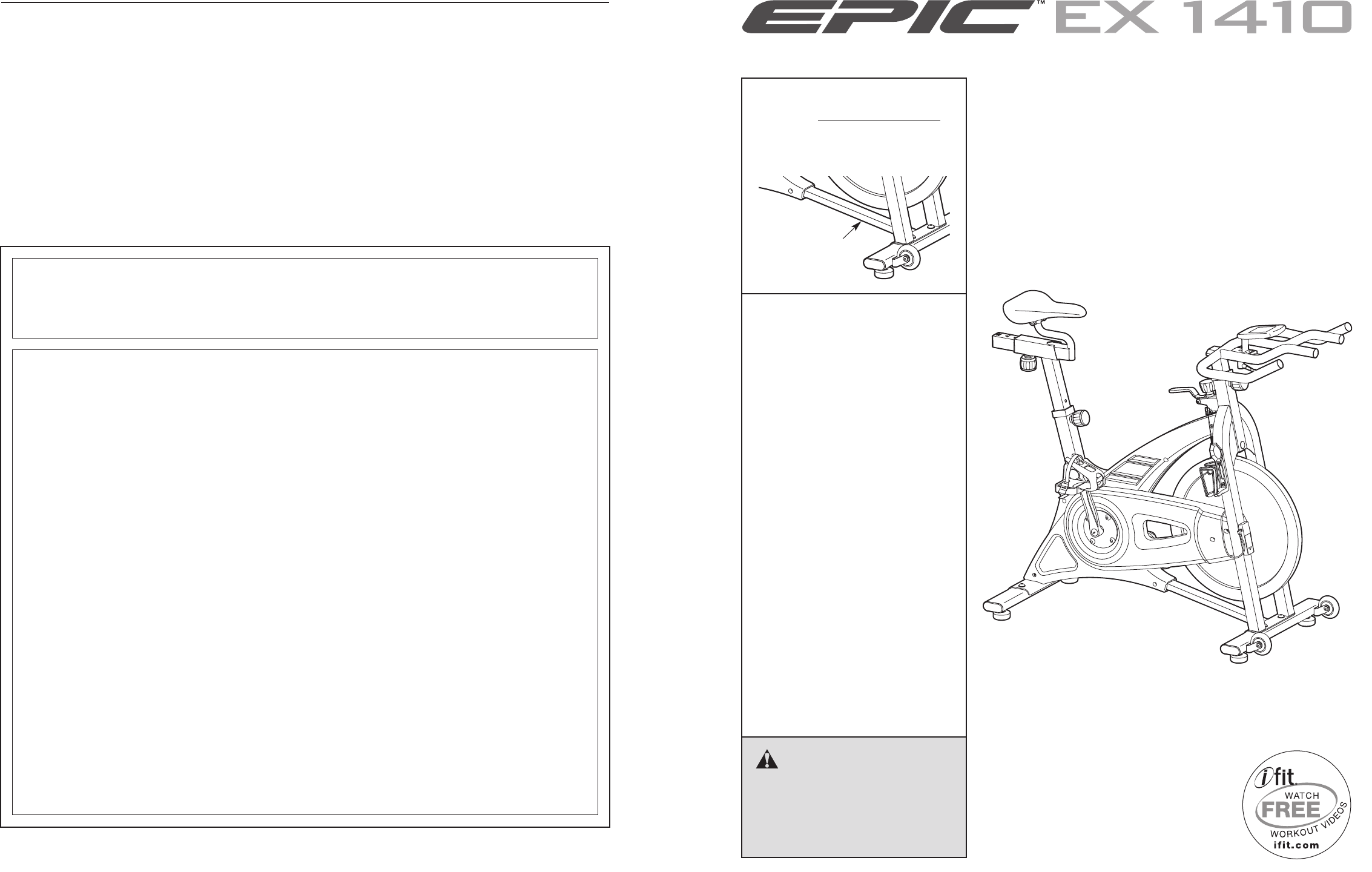
Part No. 319789 R0811A Printed in China © 2011 ICON IP, Inc.
ORDERING REPLACEMENT PARTS
To order replacement parts, please see the front cover of this manual. To help us assist you, be prepared to
provide the following information when contacting us:
• the model number and serial number of the product (see the front cover of this manual)
• the name of the product (see the front cover of this manual)
• the key number and description of the replacement part(s) (see the PART LIST and the EXPLODED
DRAWING near the end of this manual)
USERʼS MANUAL
Serial Number
Decal
CAUTION
Read all precautions and instruc-
tions in this manual before using
this equipment. Keep this manual
for future reference.
Model No. EPEX14411.0
Serial No.
Write the serial number in the
space above for reference.
QUESTIONS?
If you have questions, or if parts are
damaged or missing, DO NOT
CONTACT THE STORE; please
contact Customer Care.
IMPORTANT: Please register this
product (see the limited warranty
on the back cover of this manual)
before contacting Customer Care.
CALL TOLL-FREE:
1-866-997-6999
Mon.–Fri. 6 a.m.–6 p.m. MT
Sat. 8 a.m.–4 p.m. MT
ON THE WEB:
www.iconservice.com
ICON Health & Fitness, Inc. (ICON) warrants this product to be free from defects in workmanship and
material, under normal use and service conditions. The frame is warranted for five (5) years from the date
of purchase. Parts and labor are warranted for one (1) year from the date of purchase.
This warranty extends only to the original purchaser (customer). ICONʼs obligation under this warranty is
limited to repairing or replacing, at ICONʼs option, the product through one of its authorized service cen-
ters. All repairs for which warranty claims are made must be preauthorized by ICON. If the product is
shipped to a service center, freight charges to and from the service center will be the customerʼs respon-
sibility. If replacement parts are shipped while the product is under warranty, the customer will be
responsible for a minimal handling charge. For in-home service, the customer will be responsible for a
minimal trip charge. This warranty does not extend to freight damage to the product. This warranty will
automatically be voided if the product is used as a store display model, if the product is purchased or
transported outside the USA, if all instructions in this manual are not followed, if the product is abused or
improperly or abnormally used, or if the product is used for commercial or rental purposes. No other war-
ranty beyond that specifically set forth above is authorized by ICON.
ICON is not responsible or liable for indirect, special, or consequential damages arising out of or in con-
nection with the use or performance of the product; damages with respect to any economic loss, loss of
property, loss of revenues or profits, loss of enjoyment or use, or costs of removal or installation; or other
consequential damages of any kind. Some states do not allow the exclusion or limitation of incidental or
consequential damages. Accordingly, the above limitation may not apply to the customer.
The warranty extended hereunder is in lieu of any and all other warranties, and any implied warranties of
merchantability or fitness for a particular purpose are limited in their scope and duration to the terms set
forth herein. Some states do not allow limitations on how long an implied warranty lasts. Accordingly, the
above limitation may not apply to the customer.
This warranty provides specific legal rights; the customer may have other rights that vary from state to state.
ICON Health & Fitness, Inc., 1500 S. 1000 W., Logan, UT 84321-9813
LIMITED WARRANTY
IMPORTANT: You must register this product within 30 days of the purchase date to avoid added
fees for service needed under warranty. Go to www.iconservice.com/registration.
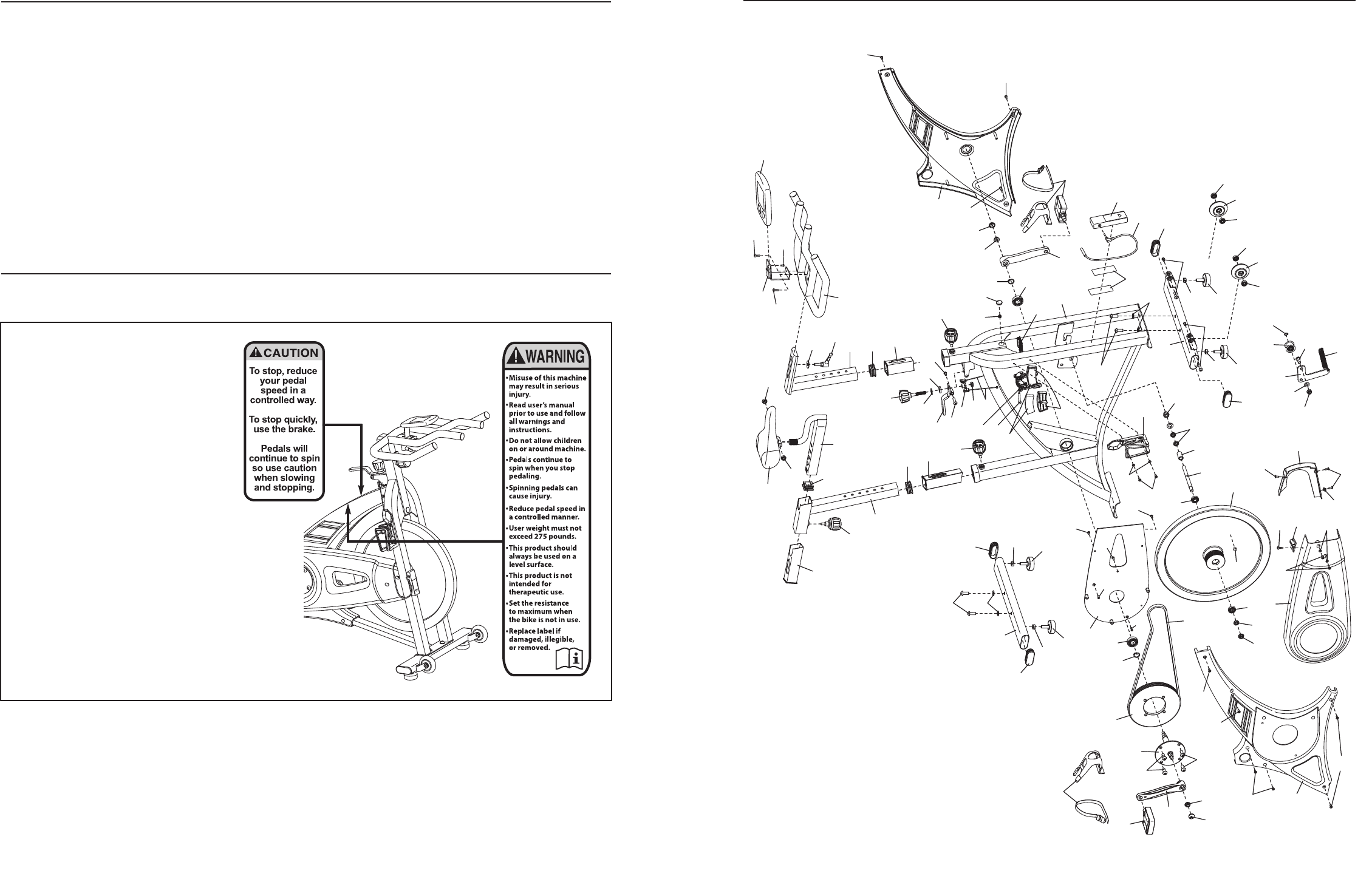
19
EXPLODED DRAWING Model No. EPEX14411.0 R0811A
1
2
345
6
7
8
910
12
13
14
15
16
16
16
16
17
18
18
18
18
19
20
22
23
23
23
24
25
28
29
30
26
27
27
31
32
33
34
33
34
35
36
37
38
39
40
41
42
43
44
44
45
45
47
48
48
49
50
50
50
50
50
50
50
50
50
50
50
50
51
52
53
53
54
55
55
56
57
58
59
59
60
60
61
61
61
61
62
68
64
64
65
65
66 67
68
68
69
70
71
71
19
19
72
73
74
63
63
21
46
46
35
11
21
46
46
68
75
78
77
79 80
81
82
83
76
76
84
2
TABLE OF CONTENTS
WARNINGDECALPLACEMENT ..............................................................2
IMPORTANTPRECAUTIONS ................................................................3
BEFOREYOUBEGIN ......................................................................4
ASSEMBLY ...............................................................................5
HOWTOUSETHEEXERCISEBIKE .........................................................10
FCCINFORMATION.......................................................................16
EXERCISEGUIDELINES ...................................................................17
PARTLIST ..............................................................................18
EXPLODEDDRAWING ....................................................................19
ORDERINGREPLACEMENTPARTS ..................................................BackCover
LIMITEDWARRANTY ..............................................................BackCover
WARNING DECAL PLACEMENT
This drawing shows the location(s)
of the warning decal(s). If a decal is
missing or illegible, see the front
cover of this manual and request
a free replacement decal. Apply
the decal in the location shown.
Note: The decal(s) may not be
shown at actual size.

18
11 Frame
21Seat Post
31Seat Carriage
41Handlebar Post
51Handlebar
61Tension Bracket
71Rear Stabilizer
81Front Stabilizer
91Brake Lever
10 1 Felt Washer
11 1 Resistance Knob
12 1 Right Cover
13 1 Left Cover
14 1 Right Shield
15 1 Left Shield
16 4 Leveling Foot
17 1 Handlebar Post Bushing
18 4 Stabilizer Cap
19 3 Post Cap
20 1 Shield Cover
21 2 Wheel
22 1 Seat
23 3 Adjustment Knob
24 1 Brake Cap
25 1 Frame Cap
26 1 Right Crank Arm
27 2 Crank Cap
28 1 Drive Belt
29 1 Tension Spring
30 1 Crank
31 1 Handle
32 1 Handle Washer
33 4 Stabilizer Washer
34 4 M10 x 25mm Screw
35 1 Right Pedal/Strap
36 1 Flywheel
37 1 Flywheel Axle
38 1 Pulley
39 1 Flywheel Sleeve
40 1 Idler Pulley
41 2 Brake Pad
42 1 Brake Clamp
43 1 Knob Washer
44 2 Flywheel Bearing
45 2 Crank Bearing
46 4 Wheel Bearing
47 1 Flywheel Snap Ring
48 2 Crank Snap Ring
49 1 T1 Nut
50 15 Self-tapping Screw
51 1 Flange Nut
52 1 Acorn Nut
53 2 Crank Nut
54 1 Caliper Brake
55 3 M12 Thin Hex Nut
56 1 M6 Flange Nut
57 1 Tension Nut
58 1 M10 Locknut
59 2 M5 x 10mm Screw
60 4 M5 Washer
61 4 M8 Hex Nut
62 2 Brake Cable
63 4 M5 x 12mm Screw
64 2 Seat Post Bushing
65 4 M10 x 16mm Bolt
66 1 Left Crank Arm
67 1 Left Pedal/Strap
68 3 M6 x 30mm Bolt Set
69 1 M6 x 40mm Bolt
70 2 Brake Pad Mount
71 2 M8 Hex Nut
72 1 Flat Washer
73 1 M10 x 25mm Bolt
74 1 Water Bottle Holder
75 1 Console
76 2 Bracket Screw
77 1 Console Screw
78 1 Console Bracket
79 1 Hook and Loop Fastener
80 1 Reed Switch
81 1 Transmitter
82 1 Clamp
83 1 Clamp Screw
84 1 Magnet
*–Assembly Tool
*–Userʼs Manual
Key No. Qty. Description Key No. Qty. Description
PART LIST Model No. EPEX14411.0 R0811A
Note: Specifications are subject to change without notice. For information about ordering replacement parts, see
the back cover of this manual. *These parts are not illustrated.
3
WARNING: To reduce the risk of serious injury, read all important precautions and
instructions in this manual and all warnings on your exercise bike before using your exercise bike.
ICON assumes no responsibility for personal injury or property damage sustained by or through the
use of this product.
1. Before beginning any exercise program,
consult your physician. This is especially
important for persons over age 35 or per-
sons with pre-existing health problems.
2. Use the exercise bike only as described in
this manual.
3. It is the responsibility of the owner to ensure
that all users of the exercise bike are ade-
quately informed of all precautions.
4. The exercise bike is intended for home use
only. Do not use the exercise bike in a com-
mercial, rental, or institutional setting.
5. Keep the exercise bike indoors, away from
moisture and dust. Do not put the exercise
bike in a garage or covered patio, or near
water.
6. Place the exercise bike on a level surface,
with a mat beneath it to protect the floor or
carpet. Make sure that there is at least 2 ft.
(0.6 m) of clearance around the exercise
bike.
7. Inspect and properly tighten all parts regu-
larly. Replace any worn parts immediately.
8. Keep children under age 12 and pets away
from the exercise bike at all times.
9. Wear appropriate clothes while exercising;
do not wear loose clothes that could become
caught on the exercise bike. Always wear
athletic shoes for foot protection.
10. The exercise bike should not be used by
persons weighing more than 275 lbs.
(125 kg).
11. Always keep your back straight while using
the exercise bike; do not arch your back.
12. The exercise bike does not have a freewheel;
the pedals will continue to move until the fly-
wheel stops. Reduce your pedaling speed in
a controlled way.
13. To stop the flywheel quickly, press the brake
lever downward.
14. When the exercise bike is not in use, tighten
the resistance knob completely to prevent
the flywheel from moving.
15. To avoid damaging the brake pads, do not
lubricate the brake pads.
16. Over exercising may result in serious injury
or death. If you feel faint or if you experience
pain while exercising, stop immediately and
cool down.
IMPORTANT PRECAUTIONS
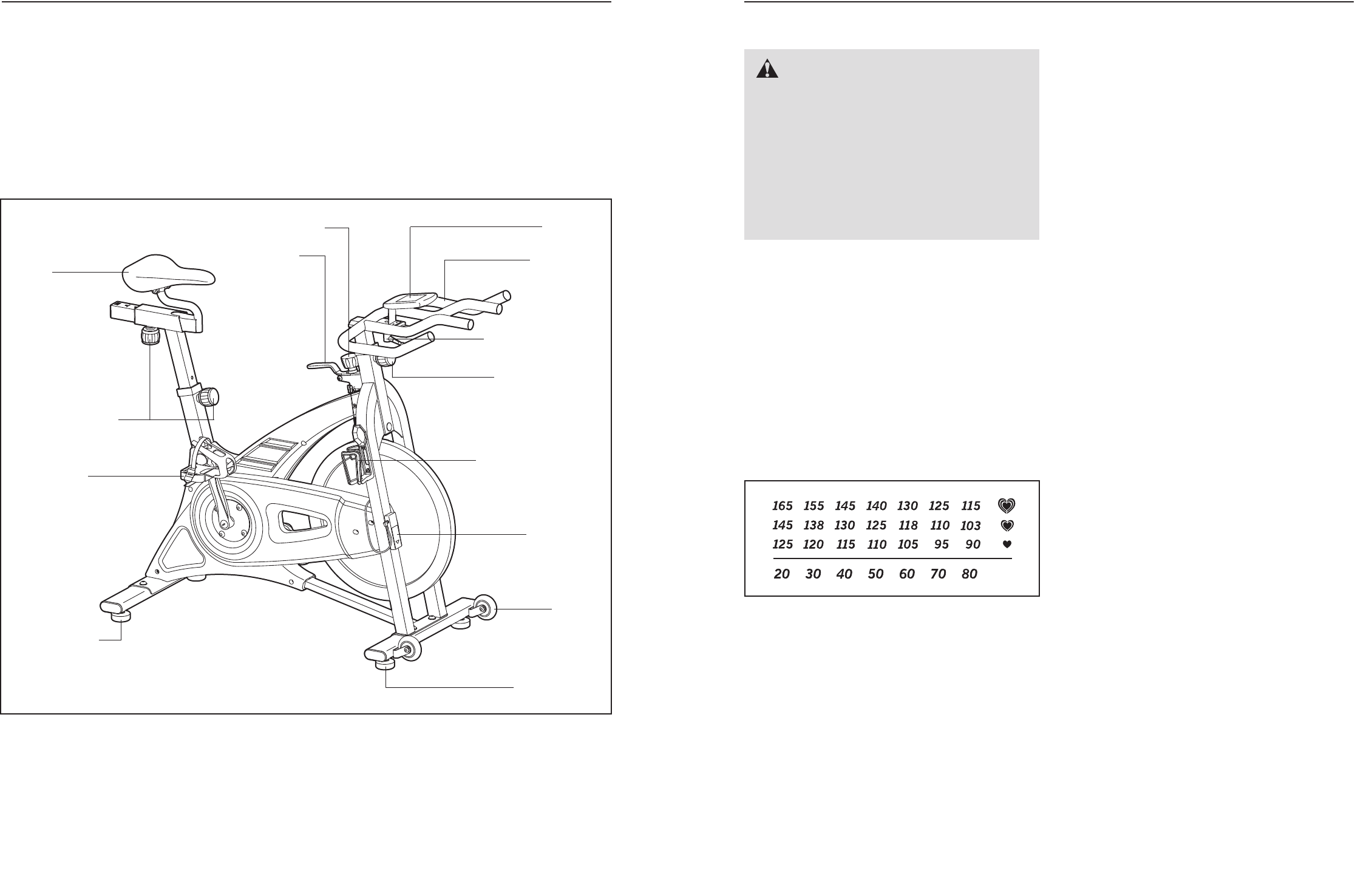
17
These guidelines will help you to plan your exercise
program. For detailed exercise information, obtain a
reputable book or consult your physician. Remember,
proper nutrition and adequate rest are essential for
successful results.
EXERCISE INTENSITY
Whether your goal is to burn fat or to strengthen your
cardiovascular system, exercising at the proper inten-
sity is the key to achieving results. You can use your
heart rate as a guide to find the proper intensity level.
The chart below shows recommended heart rates for
fat burning and aerobic exercise.
To find the proper intensity level, find your age at the
bottom of the chart (ages are rounded off to the near-
est ten years). The three numbers listed above your
age define your “training zone.” The lowest number is
the heart rate for fat burning, the middle number is the
heart rate for maximum fat burning, and the highest
number is the heart rate for aerobic exercise.
Burning Fat—To burn fat effectively, you must exer-
cise at a low intensity level for a sustained period of
time. During the first few minutes of exercise, your
body uses carbohydrate calories for energy. Only after
the first few minutes of exercise does your body begin
to use stored fat calories for energy. If your goal is to
burn fat, adjust the intensity of your exercise until your
heart rate is near the lowest number in your training
zone. For maximum fat burning, exercise with your
heart rate near the middle number in your training
zone.
Aerobic Exercise—If your goal is to strengthen your
cardiovascular system, you must perform aerobic
exercise, which is activity that requires large amounts
of oxygen for prolonged periods of time. For aerobic
exercise, adjust the intensity of your exercise until
your heart rate is near the highest number in your
training zone.
WORKOUT GUIDELINES
Warming Up—Start with 5 to 10 minutes of stretching
and light exercise. A warm-up increases your body
temperature, heart rate, and circulation in preparation
for exercise.
Training Zone Exercise—Exercise for 20 to 30 min-
utes with your heart rate in your training zone. (During
the first few weeks of your exercise program, do not
keep your heart rate in your training zone for longer
than 20 minutes.) Breathe regularly and deeply as you
exercise—never hold your breath.
Cooling Down—Finish with 5 to 10 minutes of
stretching. Stretching increases the flexibility of your
muscles and helps to prevent post-exercise problems.
EXERCISE FREQUENCY
To maintain or improve your condition, complete three
workouts each week, with at least one day of rest
between workouts. After a few months of regular exer-
cise, you may complete up to five workouts each
week, if desired. Remember, the key to success is to
make exercise a regular and enjoyable part of your
everyday life.
EXERCISE GUIDELINES
WARNING: Before beginning this
or any exercise program, consult your physi-
cian. This is especially important for persons
over age 35 or persons with pre-existing
health problems.
The heart rate monitor is not a medical device.
Various factors may affect the accuracy of
heart rate readings. The heart rate monitor is
intended only as an exercise aid in determin-
ing heart rate trends in general.
4
Thank you for selecting the new EPIC™ EX 1410
exercise bike. Cycling is an effective exercise for
increasing cardiovascular fitness, building endurance,
and toning the body. The EX 1410 exercise bike pro-
vides a selection of features designed to make your
workouts at home more effective and enjoyable.
For your benefit, read this manual carefully before
you use the exercise bike. If you have questions
after reading this manual, please see the front cover
of this manual. To help us assist you, note the product
model number and serial number before contacting
us. The model number and the location of the serial
number decal are shown on the front cover of this
manual.
Before reading further, please familiarize yourself with
the parts that are labeled in the drawing below.
Resistance Knob
Brake Lever
Seat
Adjustment Knob
Adjustment Knob
Adjustment Handle
Pedal/Strap
Water Bottle Holder*
Leveling Foot
Handlebar
Console
Transmitter
BEFORE YOU BEGIN
Wheel
Leveling Foot
*Water bottle is not included
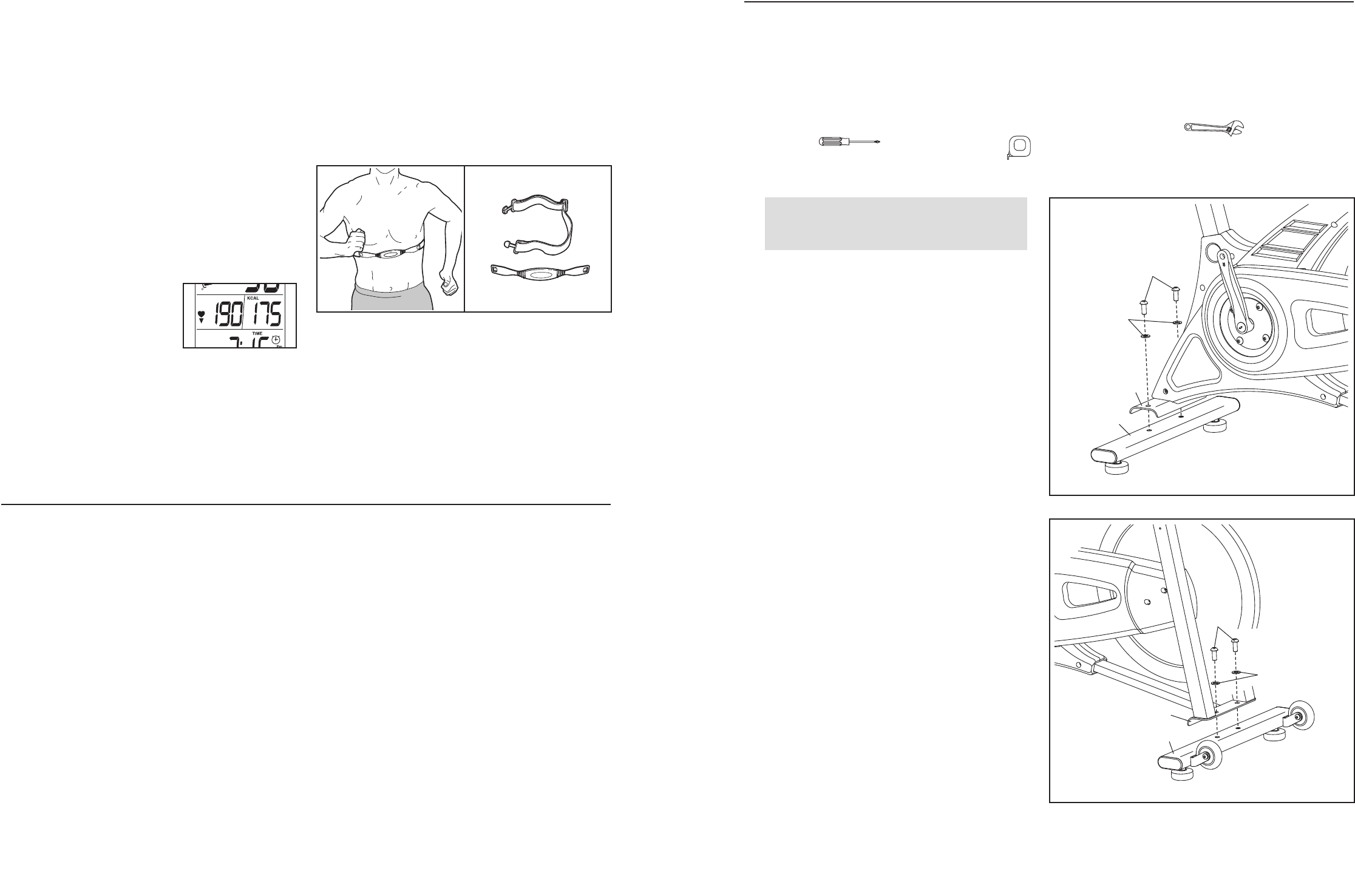
16
HOW TO USE THE HEART RATE ALARM
The heart rate alarm will alert you when your heart
rate is below or above a defined target heart rate
zone.
IMPORTANT: You must wear an optional heart rate
monitor to use the heart rate alarm (see THE
OPTIONAL CHEST HEART RATE MONITOR at the
right).
To use the heart rate alarm, first see step 4 on page
13 and define a target heart rate zone.
As you pedal, the console will regularly compare your
heart rate to the target heart rate zone and will indi-
cate if your heart rate is too far below or above the
target heart rate zone.
When a downward-pointing
arrow flashes in the middle
left display, increase your
pedaling speed.
When an upward-pointing arrow flashes in the middle
left display, decrease your pedaling speed.
IMPORTANT: The heart rate alarm is intended only
to provide motivation. Make sure to pedal at a
speed that is comfortable for you.
THE OPTIONAL CHEST HEART RATE MONITOR
Whether your goal is to burn fat or to strengthen your
cardiovascular system, the key to achieving the best
results is to maintain the proper heart rate during your
workouts. The optional chest heart rate monitor will
enable you to continuously monitor your heart rate
while you exercise, helping you to reach your personal
fitness goals. To purchase a chest heart rate moni-
tor, please see the front cover of this manual.
FCC INFORMATION
This equipment has been tested and found to comply with the limits for a Class B digital device, pursuant to Part
15 of the FCC Rules. These limits are designed to provide reasonable protection against harmful interference in
a residential installation. This equipment generates, uses, and can radiate radio frequency energy and, if not
installed and used in accordance with the instructions, may cause harmful interference to radio communications.
However, there is no guarantee that interference will not occur in a particular installation. If this equipment does
cause harmful interference to radio or television reception, which can be determined by turning the equipment
off and on, try to correct the interference by one of the following measures:
• Reorient or relocate the receiving antenna.
• Increase the separation between the equipment and the receiver.
• Connect the equipment to an outlet on a circuit different from the circuit to which the receiver is connected.
• Consult the dealer or an experienced radio/TV technician for help.
FCC CAUTION: To assure continued compliance, use only shielded interface cables when connecting to
computer or peripheral devices. Changes or modifications not expressly approved by the party respon-
sible for compliance could void the user's authority to operate this equipment.
5
ASSEMBLY
To hire an authorized service technician to assemble the exercise bike, call 1-800-445-2480.
Assembly requires two persons. Place all parts of the exercise bike in a cleared area and remove the packing
materials. Do not dispose of the packing materials until assembly is completed.
In addition to the included tool(s), assembly requires an adjustable wrench , a Phillips
screwdriver , and a tape measure .
Note: If a part is not in the hardware kit, check to see if it has been preattached.
1.
Remove the two screws, the two washers, and
the shipping bracket (not shown) from the rear
of the Frame (1). Discard the screws, washers,
and shipping bracket.
Identify the Rear Stabilizer (7), which does not
have wheels.
Attach the Rear Stabilizer (7) to the Frame (1)
with two M10 x 25mm Screws (34) and two
Stabilizer Washers (33).
2. Remove the two screws, the two washers, and
the shipping bracket (not shown) from the front
of the Frame (1). Discard the screws, washers,
and shipping bracket.
Attach the Front Stabilizer (8) to the Frame (1)
with two M10 x 25mm Screws (34) and two
Stabilizer Washers (33).
1
34
33
8
1
1
7
34
33
2
To make assembly easier, read the
information above before you begin.
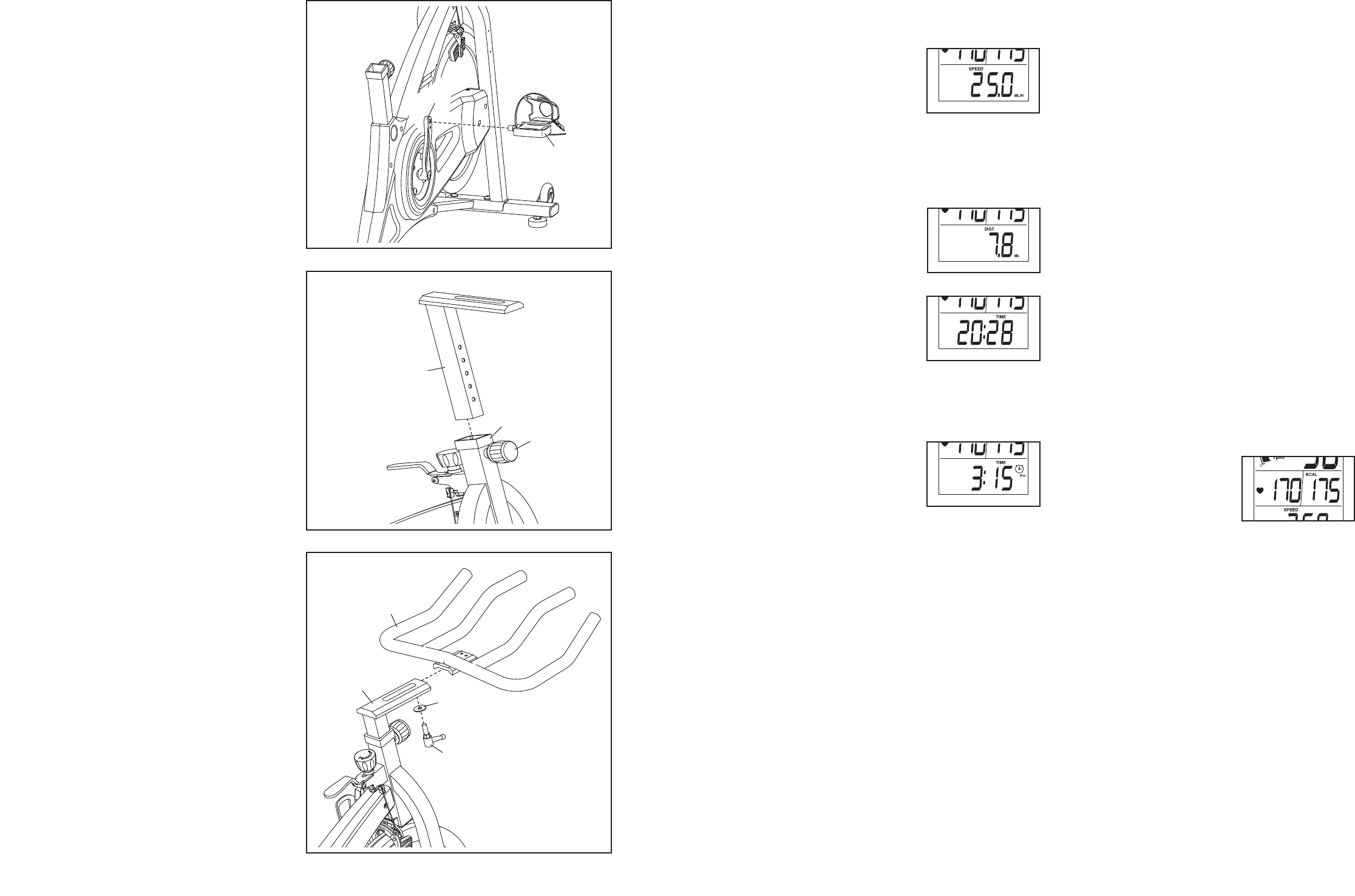
15
The lower display—This display can show the
following workout information:
Speed (SPEED)—This
display shows your
pedaling speed in
miles per hour (ML/H)
or kilometers per hour
(KM/H).
Note: When you stop pedaling, this display
shows the average pedaling speed (AVG
SPEED) for your workout.
Distance (DIST)—This
display shows the dis-
tance you have
pedaled in miles (ML)
or kilometers (KM).
Time (TIME)—This
display shows the
elapsed time in a
range from 0 minutes
to 99 minutes.
Note: If you set a time goal (see step 4), this
display shows the time remaining in your work-
out instead of the elapsed time.
Clock (Clock
symbol)—This display
shows the time of day
using a 12-hour clock
or a 24-hour clock.
Press the Left button repeatedly until the lower
display shows the workout information you are
interested in viewing.
To reset the displays, press the Left button repeat-
edly until the word TIME appears in the lower
display. Then, press and hold the Right button until
zeros appear in the displays.
To turn on the console backlight for a few sec-
onds, press the Right button once at any time.
Note: The console can display speed and dis-
tance in either miles or kilometers. The letters
ML/H or KM/H will appear in the display to show
which unit of measurement is selected. To change
the unit of measurement, see step 6 on page 13.
4. Set a time goal, if desired.
To set a time goal, see step 3 on page 12.
To clear the time goal, press the Left button
repeatedly until the word TIME appears in the
lower display. Then, press and hold the Right but-
ton until zeros appear in the lower display.
Note: If you set a time goal, the lower display will
count down the time remaining in your workout
instead of the elapsed time.
When you reach your goal, a tone will sound for
several seconds. Then, the console will begin to
count the elapsed time.
5. Measure your heart rate if desired.
To display your heart rate, you must wear an
optional heart rate monitor (see page 16).
When your heart rate is
detected, the heart sym-
bol will flash and your
heart rate will be shown
in the middle left display.
6. When you are finished exercising, the console
will turn off automatically.
The console has an auto-off feature. If the pedals
do not move and the buttons are not pressed for a
few minutes, the power will turn off automatically
to save the batteries.
6
4. Orient the Handlebar Post (4) as shown.
Locate the Adjustment Knob (23) on the front of
the Frame (1). Loosen the Adjustment Knob
and pull it outward. Then, insert the Handlebar
Post (4) into the Frame.
Move the Handlebar Post (4) upward or down-
ward to the desired position, release the
Adjustment Knob (23) into an adjustment hole
in the Handlebar Post, and then tighten the
Adjustment Knob. Make sure that the
Adjustment Knob is firmly engaged in an
adjustment hole.
3
4
3. Identify the Right Pedal (35), which is marked
with an “R.”
Using an adjustable wrench, firmly tighten the
Right Pedal (35) clockwise into the Right
Crank Arm (26).
Tighten the Left Pedal (not shown) counter-
clockwise into the Left Crank Arm (not shown).
35
4
23
1
26
5. Attach the Handlebar (5) to the Handlebar Post
(4) with the Handle (31) and the Handle Washer
(32).
Note: The Handle (31) functions like a ratchet.
Turn the Handle clockwise, pull the Handle out-
ward, turn the Handle counterclockwise, push
the Handle inward, and then turn the Handle
clockwise again. Repeat this process until the
Handle is tight.
5
4
5
32
31
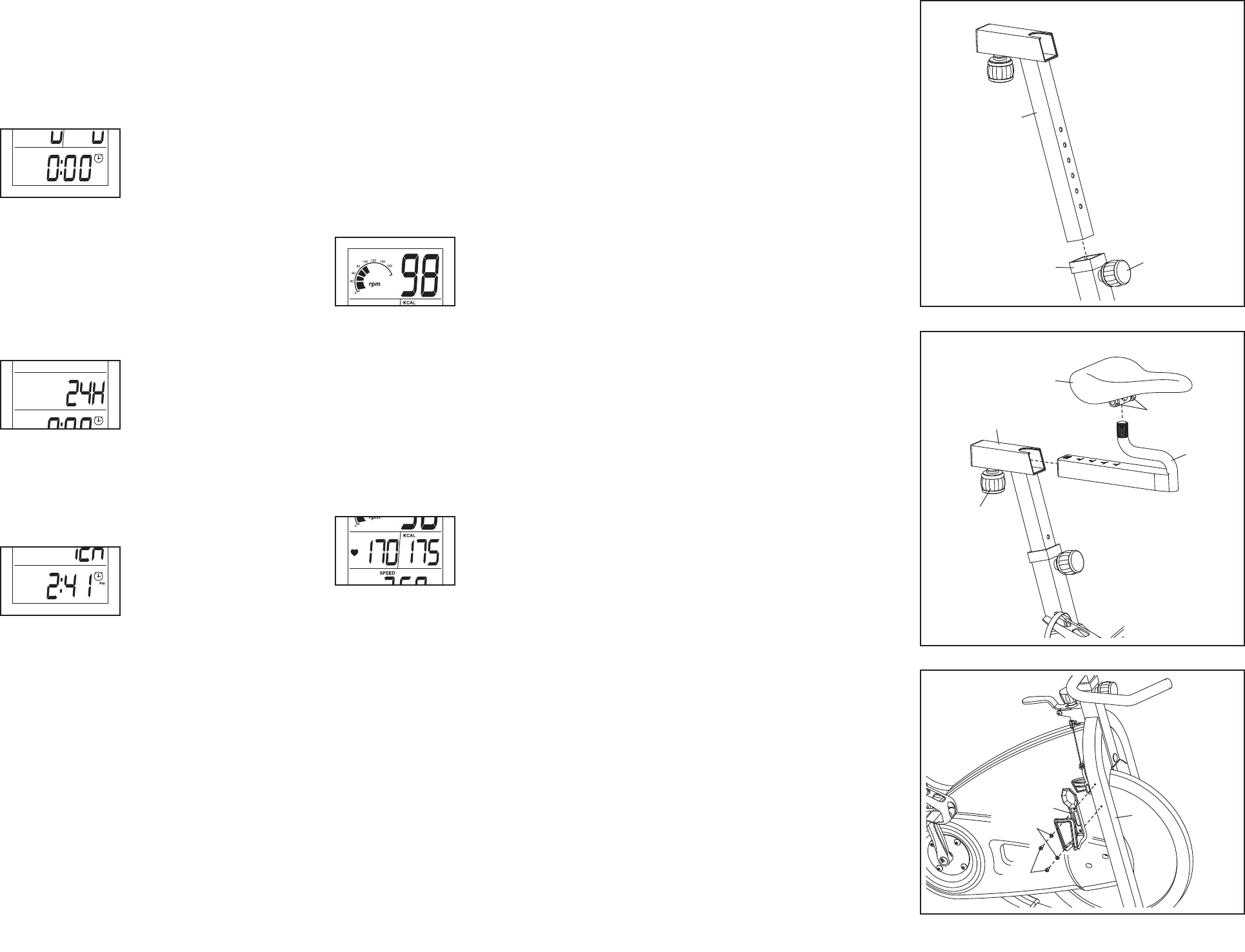
14
HOW TO SET THE CLOCK
1. Turn on the console.
Press any button to turn on the console.
2. Enter the clock mode.
First, press the Left but-
ton repeatedly until the
clock symbol appears in
the lower display.
Then, press and hold the Right button for several
seconds to enter the clock mode.
Note: The console will exit the clock mode auto-
matically if several seconds pass and no buttons
are pressed.
3. Change the time notation if desired.
The time notation will
flash in the middle right
display.
Press the Right button repeatedly to select the
desired time notation. Select 12H for a 12-hour
clock. Select 24H for a 24-hour clock.
4. Set the time.
Press the Left button to
select the hour setting.
The hour setting will flash
in the lower display.
Press the Right button repeatedly to select the
desired hour setting. Make sure to select the
correct am or pm setting when you select the
hour setting.
Press the Left button to select the minute setting.
The minute setting will flash in the lower display.
Press the Right button repeatedly to select the
desired minute setting.
5. Exit the clock mode at any time.
The console will exit the clock mode automatically
if several seconds pass and no buttons are
pressed.
HOW TO USE THE CONSOLE
1. Turn on the console.
Press any button to turn on the console.
2. Wear an optional heart rate monitor if desired.
To display your heart rate (see step 3) or use the
heart rate alarm (see HOW TO USE THE HEART
RATE ALARM on page 16), you must wear an
optional heart rate monitor (see page 16).
3. Follow your progress with the displays.
The upper left display—
As you pedal, the rpm
meter in this display indi-
cates your approximate
pedaling speed in revolu-
tions per minute (rpm) in
a range from 0 rpm to 200 rpm. Bars will appear
or disappear in increments as you change your
pedaling speed.
The upper right display—This display shows
your pedaling speed in revolutions per minute
(rpm) in a range from 0 rpm to 240 rpm.
Note: When you stop pedaling, this display shows
the average pedaling speed (AVG rpm) for your
workout.
The middle left
display—This display
shows your heart rate
(heart symbol) in beats
per minute (bpm) in a
range from 0 to 240 bpm
when you wear an optional heart rate monitor (see
page 16).
The middle right display—This display shows
the approximate number of calories (KCAL) you
have burned.
7
6
6. Orient the Seat Post (2) as shown.
Locate the Adjustment Knob (23) on the rear of
the Frame (1). Loosen the Adjustment Knob
and pull it outward. Then, insert the Seat Post
(2) into the Frame.
Move the Seat Post (2) upward or downward to
the desired position, release the Adjustment
Knob (23) into an adjustment hole in the Seat
Post, and then tighten the Adjustment Knob.
Make sure that the Adjustment Knob is
firmly engaged in an adjustment hole.
2
123
7
3
271
22
7. Orient the Seat (22) and the Seat Carriage (3)
as shown.
Attach the Seat (22) to the Seat Carriage (3)
with two M8 Hex Nuts (71). Make sure that the
nose of the Seat is pointing straight ahead
before you tighten the Hex Nuts.
Locate the Adjustment Knob (23) on the Seat
Post (2). Loosen the Adjustment Knob and pull
it outward. Then, insert the Seat Carriage (3)
into the Seat Post.
Slide the Seat Carriage (3) to the desired posi-
tion, release the Adjustment Knob (23) into one
of the adjustment holes in the Seat Carriage,
and then tighten the Adjustment Knob. Make
sure that the Adjustment Knob is firmly
engaged in an adjustment hole.
23
8
1
74
60
63
8. Attach the Water Bottle Holder (74) to the
Frame (1) with two M5 x 12mm Screws (63)
and two M5 Washers (60).
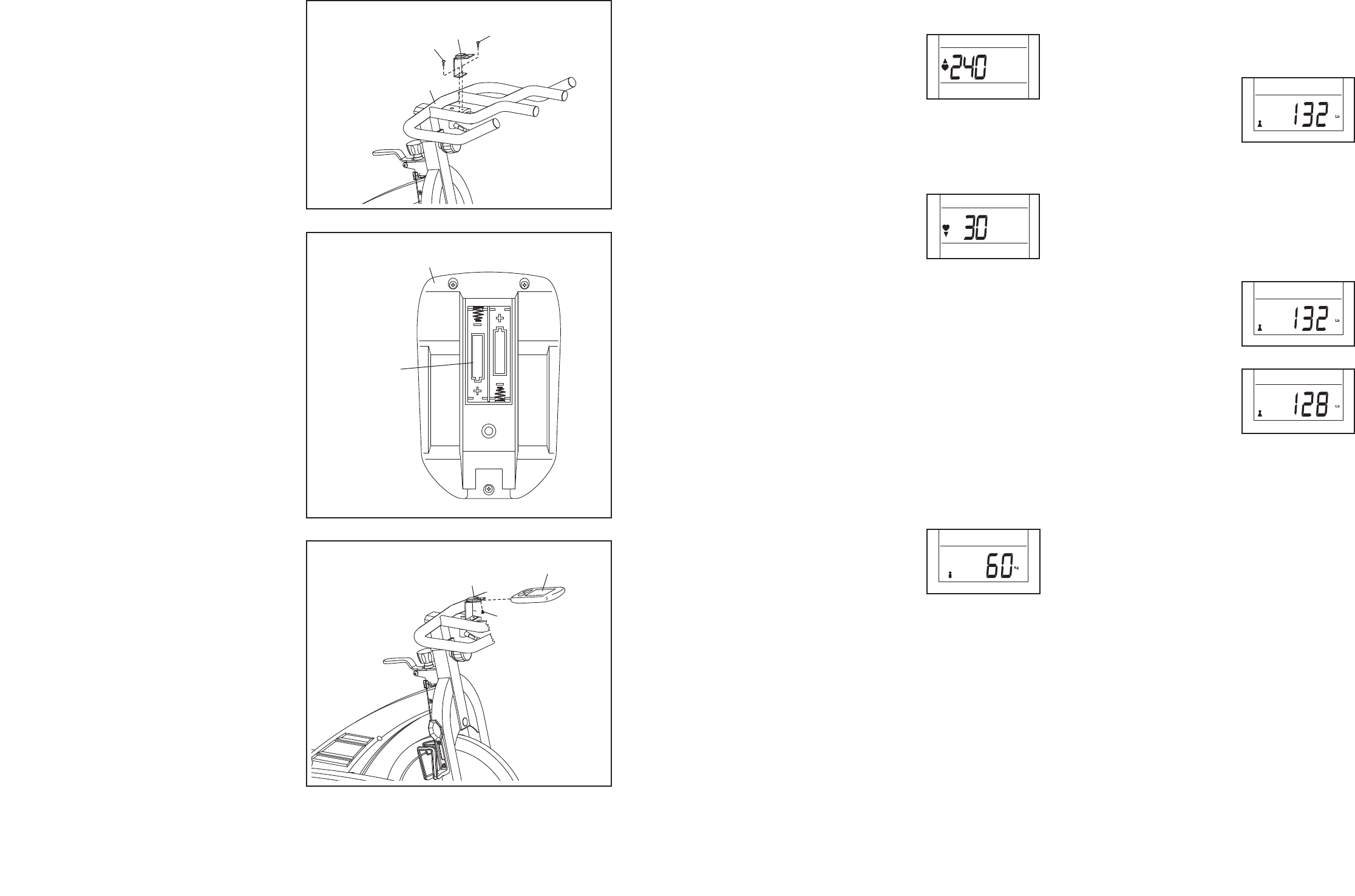
13
4. Define the target heart rate zone if desired.
The maximum heart rate
will flash in the middle left
display.
To set the maximum heart rate, press the Right
button repeatedly to select the desired heart rate.
To select a heart rate quickly, press and hold down
the Right button.
Next, press the Left but-
ton. The minimum heart
rate will flash in the mid-
dle left display.
To set the minimum heart rate, press the Right
button repeatedly to select the desired heart rate.
To select a heart rate quickly, press and hold down
the Right button.
Note: You must define a target heart rate zone to
use the heart rate alarm (see HOW TO USE THE
HEART RATE ALARM on page 16).
To determine your target heart rate zone, see
EXERCISE INTENSITY on page 17.
Press the Left button to advance to the next set-
ting.
5. Enter your gender if desired.
A gender symbol will
flash in the lower display.
Press the Right button repeatedly to select the
symbol that represents your gender.
Press the Left button to advance to the next set-
ting.
6. Select a unit of measurement if desired.
The console can display speed, distance, and
weight in standard or metric measurements.
The letters Lb (standard)
or Kg (metric) will flash in
the lower display to show
which unit of measure-
ment is selected.
Press the Right button repeatedly to select the
desired unit of measurement.
Press the Left button to advance to the next set-
ting.
7. Enter your weight if desired.
A weight setting will flash
in the lower display.
Press the Right button
repeatedly to select your
weight. To select your
weight quickly, press and
hold down the Right
button.
Note: You can select a weight setting between 44
and 396 pounds or between 20 and 180 kilo-
grams. The exercise bike should not be used
by persons weighing more than 275 pounds or
125 kilograms.
8. Exit the setup mode at any time.
The console will exit the setup mode automatically
if several seconds pass and no buttons are
pressed.
Note: To advance again through the settings
described in steps 3 to 7, press the Left button
repeatedly.
8
9
9. Attach the Console Bracket (78) to the
Handlebar (5) with two Bracket Screws (76).
5
78 76
76
10
10. The Console (75) requires two AAA batteries
(not included); alkaline batteries are recom-
mended. IMPORTANT: If the Console has
been exposed to cold temperatures, allow it
to warm to room temperature before you
insert batteries. Otherwise, you may damage
the console display or other electronic com-
ponents.
Remove the battery cover from the back of the
Console (75), and insert batteries into the bat-
tery compartment. Make sure that the
batteries are oriented as shown by the dia-
grams inside the battery compartment. Then,
reattach the battery cover.
75
Battery
Compartment
11
11. Attach the Console (75) to the Console Bracket
(78) with a Console Screw (77).
77
75
78
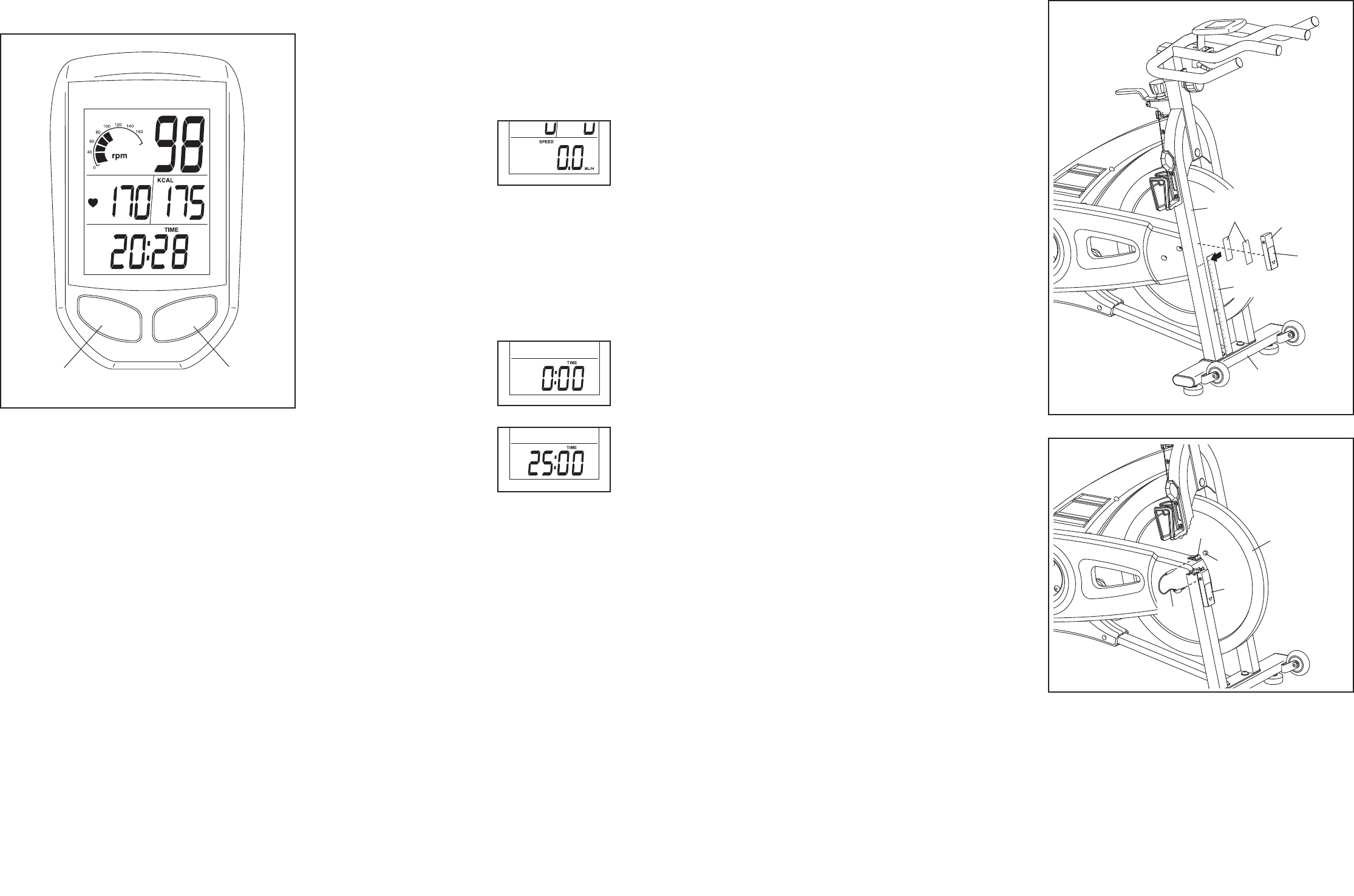
12
CONSOLE DIAGRAM
FEATURES OF THE CONSOLE
The console offers a selection of features designed to
provide instant exercise feedback and make your
workouts more effective.
The console features a heart rate alarm that helps you
keep your heart rate within your selected target heart
rate zone while you exercise. Note: To use this fea-
ture, you must wear an optional heart rate monitor (see
page 16).
The console also allows you to personalize settings,
select a system of measurement, and enter user infor-
mation before you begin exercising.
To personalize console settings, see the instruc-
tions at the right. To set the clock, see page 14. To
use the console, see page 14. To use the heart rate
alarm, see page 16.
Before using the console, make sure that batteries are
installed in the console and the transmitter (see
assembly step 10 on page 8 and assembly step 12 on
page 9). If there is a sheet of plastic on the display,
remove the plastic.
HOW TO PERSONALIZE CONSOLE SETTINGS
1. Turn on the console.
Press any button to turn on the console.
2. Enter the setup mode.
First, press the Left but-
ton repeatedly until the
word SPEED appears in
the lower display.
Then, press and hold the Right button for several
seconds to enter the setup mode.
Note: The console will exit the setup mode auto-
matically if several seconds pass and no buttons
are pressed.
3. Set a time goal if desired.
When you enter the setup
mode, the minutes place
in the lower display will
flash.
To set a time goal for
your workout, press the
Right button repeatedly to
select the desired number
of minutes. To select a
time goal quickly, press
and hold down the Right button.
Note: You can set a time goal between 1 and 99
minutes.
Note: If you set a time goal, the lower display will
count down the time remaining in your workout
instead of the elapsed time (see step 3 of HOW
TO USE THE CONSOLE on page 14).
Press the Left button to advance to the next
setting.
Left
Button
Right
Button
9
12
12. The Transmitter (81) requires two AAA batteries
(not included); alkaline batteries are recom-
mended.
Remove the battery cover from the front of the
Transmitter (81), and insert batteries into the
battery compartment. Make sure that the bat-
teries are oriented as shown by the
diagrams inside the battery compartment.
Then, reattach the battery cover.
IMPORTANT: From the top of the stabilizer,
measure 11 1/2 in. (29 cm) along the Frame
(1) as shown. The Transmitter (81) must be
attached in this location.
Remove the adhesive backing from the Hook
and Loop Fasteners (79). Press a Fastener
onto the Frame (1) in the indicated location.
Orient the Transmitter (81) as shown. Press the
other Fastener (79) onto the back of the
Transmitter.
Attach the Transmitter (81) to the Frame (1)
using the Hook and Loop Fasteners (79).
81
79
1
Battery
Cover
11.5" (29 cm)
13
13. Plug the Reed Switch (80) into the Transmitter
(81).
Insert the other end of the Reed Switch (80)
into the Clamp (82).
Rotate the Flywheel (36) until the Magnet (84)
is aligned with the end of the Reed Switch (80).
Move the Reed Switch (80) so that the gap
between the Reed Switch and the Magnet (84)
is about 1/8 in. (3 mm).
36
84
82
81
14. Make sure that all parts are properly tightened before you use the exercise bike. Note: After assembly
is completed, some extra parts may be left over. Place a mat beneath the exercise bike to protect the floor.
Stabilizer
80

11
HOW TO ADJUST THE PEDAL STRAPS
To tighten the pedal straps (see the drawing on page
4), simply pull the ends of the pedal straps. To loosen
the pedal straps, press and hold the tabs on the buck-
les, adjust the pedal straps to the desired position,
and then release the tabs.
HOW TO ADJUST THE PEDALING RESISTANCE
To increase the
resistance of the
pedals, turn the
resistance knob
clockwise; to
decrease the resis-
tance, turn the
resistance knob
counterclockwise. To
stop the flywheel,
push the brake
lever downward.
The flywheel should quickly come to a complete
stop.
IMPORTANT: When the exercise bike is not in use,
tighten the resistance knob completely.
HOW TO LEVEL THE EXERCISE BIKE
If the exercise bike rocks slightly on your floor during
use, turn one or both of the leveling feet on the front
or rear stabilizer (see the drawing on page 4) until the
rocking motion is eliminated.
HOW TO MAINTAIN THE EXERCISE BIKE
Inspect and tighten all parts of the exercise bike regu-
larly. Replace any worn parts immediately.
To clean the exercise bike, use a damp cloth and a
small amount of mild detergent. IMPORTANT: To
avoid damage to the console, keep liquids away
from the console and keep the console out of
direct sunlight.
HOW TO ADJUST THE REED SWITCH
If the console does not display correct feedback, the
reed switch should be adjusted. To adjust the reed
switch, see the drawing in assembly step 13 on page
9.
Rotate the flywheel until the magnet is aligned with the
reed switch. Slide the reed switch slightly toward or
away from the magnet. Then, rotate the flywheel for a
moment. Repeat these actions until the console dis-
plays correct feedback.
Brake
Lever
Resistance
Knob
10
HOW TO USE THE EXERCISE BIKE
HOW TO ADJUST THE ANGLE OF THE SEAT
You can adjust the angle of the seat to the position
that is most comfortable. You can also slide the seat
forward or backward to increase your comfort or to
adjust the distance to the handlebar.
To adjust the seat, see the drawing in assembly step 7
on page 7. Loosen the nuts on the seat clamp a few
turns, and then tilt the seat upward or downward or
slide the seat forward or backward to the desired posi-
tion. Then, retighten the nuts.
HOW TO ADJUST THE HORIZONTAL POSITION OF
THE SEAT
To adjust the hori-
zontal position of the
seat, first loosen the
adjustment knob and
pull it downward.
Then, move the seat
forward or backward,
release the adjust-
ment knob into an
adjustment hole in
the seat carriage, and firmly tighten the adjustment
knob. Make sure that the adjustment knob is
engaged in an adjustment hole.
HOW TO ADJUST THE SEAT POST
For effective exercise, the seat should be at the
proper height. As you pedal, there should be a slight
bend in your knees when the pedals are in the lowest
position.
To adjust the height
of the seat post, first
loosen the adjust-
ment knob and pull it
outward. Then, move
the seat post upward
or downward,
release the adjust-
ment knob into an
adjustment hole in
the seat post, and
firmly tighten the adjustment knob. Make sure that
the adjustment knob is engaged in an adjustment
hole.
HOW TO ADJUST THE HORIZONTAL POSITION OF
THE HANDLEBAR
To adjust the horizon-
tal position of the
handlebar, loosen the
handle, move the
handlebar forward or
backward to the
desired position, and
then tighten the
handle.
Note: The handle functions like a ratchet. To loosen
the handle, turn the handle counterclockwise, pull the
handle outward, turn the handle clockwise, push the
handle inward, and then turn the handle counterclock-
wise again. Reverse this process to tighten the
handle.
HOW TO ADJUST THE HANDLEBAR POST
To adjust the height
of the handlebar
post, first loosen the
adjustment knob and
pull it outward. Then,
move the handlebar
post upward or
downward, release
the adjustment knob
into an adjustment
hole in the handlebar
post, and firmly
tighten the adjust-
ment knob. Make sure that the adjustment knob is
engaged in an adjustment hole.
Seat
Adjustment
Knob
Adjustment
Knob
Handlebar
Post
Handle
Handlebar
Seat
Post
Adjustment
Knob